Related Research Articles

The Muscogee, also known as the Mvskoke, Muscogee Creek, and the Muscogee Creek Confederacy, are a group of related Indigenous peoples of the Southeastern Woodlands in the United States of America. Their historical homelands are in what now comprises southern Tennessee, much of Alabama, western Georgia and parts of northern Florida.
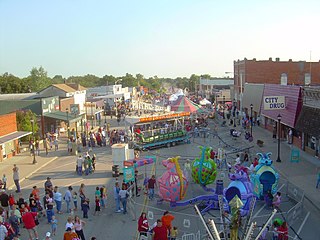
Coweta is a city in Wagoner County, Oklahoma, United States, a suburb of Tulsa. As of 2010, its population was 9,943. Part of the Creek Nation in Indian Territory before Oklahoma became a U.S. state, the town was first settled in 1840.
Tullahassee is a town in Wagoner County, Oklahoma, United States. The population was 106 in both the 2010 and the 2000 censuses. It was the location of Tullahassee Mission, an Indian boarding school that burned in 1880. Because their population in the community had declined, the Muscogee Creek gave the school to Creek Freedmen, paying to replace the main building, and relocated with their families to the area of Wealaka Mission.

The term Five Civilized Tribes was applied by European Americans in the colonial and early federal period in the history of the United States to the five major Native American nations in the Southeast—the Cherokee, Chickasaw, Choctaw, Muscogee, and Seminoles. Americans of European descent classified them as "civilized" because they had adopted attributes of the Anglo-American culture. Examples of such colonial attributes adopted by these five tribes included Christianity, centralized governments, literacy, market participation, written constitutions, intermarriage with white Americans, and chattel slavery practices, including purchase of enslaved African Americans. For a period, the Five Civilized Tribes tended to maintain stable political relations with the European Americans, before the United States promoted Indian removal of these tribes from the Southeast.
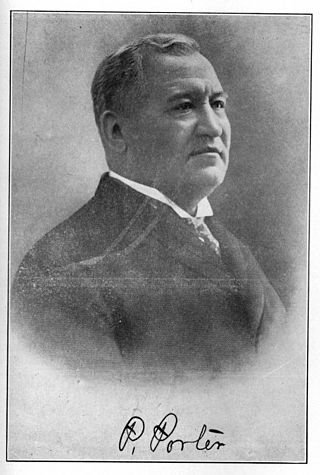
Pleasant Porter, was an American Indian statesman and the last elected Principal Chief of the Creek Nation, serving from 1899 until his death.

The Black Seminoles, or Afro-Seminoles, are Native American-Africans associated with the Seminole people in Florida and Oklahoma. They are mostly blood descendants of the Seminole people, free Africans, and escaped former slaves, who allied with Seminole groups in Spanish Florida. Many have Seminole lineage, but due to the stigma of having very dark or brown skin and kinky hair, they all have been categorized as slaves or freedmen.
Chahta Tamaha served as the capital of the Choctaw Nation from 1863 to 1883 in Indian Territory. The town developed initially around the Armstrong Academy, which was operated by Protestant religious missionaries from 1844 to 1861 to serve Choctaw boys. After the capital was relocated to another town, this community declined.

The Muscogee Nation, or Muscogee (Creek) Nation, is a federally recognized Native American tribe based in the U.S. state of Oklahoma. The nation descends from the historic Muscogee Confederacy, a large group of indigenous peoples of the Southeastern Woodlands. Official languages include Muscogee, Yuchi, Natchez, Alabama, and Koasati, with Muscogee retaining the largest number of speakers. They commonly refer to themselves as Este Mvskokvlke. Historically, they were often referred to by European Americans as one of the Five Civilized Tribes of the American Southeast.

Koweta Mission Site is a site near Coweta, Oklahoma, and listed on the National Register of Historic Places. The mission was started in 1843 by Presbyterian minister Robert Loughridge at Coweta, then the capital of the Creek Nation, Indian Territory. He named the mission "Koweta", after the Creek capital. The school operated until the American Civil War, when Loughridge and most missionaries left the territory.

Robert McGill Loughridge was an American Presbyterian missionary who served among the Creek in Indian Territory. He attended Miami University, Ohio, and graduated in 1837. Loughridge was ordained as a Presbyterian minister in October 1842.
David McKellop Hodge was an attorney and interpreter for the Creek Nation, and was politically active. He became an orator and a leader on the Creek Nation Council at Muskogee, the capital.
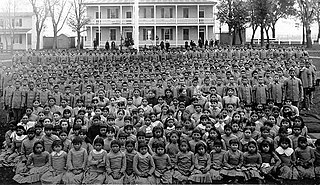
American Indian boarding schools, also known more recently as American Indian residential schools, were established in the United States from the mid-17th to the early 20th centuries with a primary objective of "civilizing" or assimilating Native American children and youth into European American culture. In the process, these schools denigrated Native American culture and made children give up their languages and religion. At the same time the schools provided a basic Western education. These boarding schools were first established by Christian missionaries of various denominations. The missionaries were often approved by the federal government to start both missions and schools on reservations, especially in the lightly populated areas of the West. In the late 19th and early 20th centuries especially, the government paid religious orders to provide basic education to Native American children on reservations, and later established its own schools on reservations. The Bureau of Indian Affairs (BIA) also founded additional off-reservation boarding schools based on the assimilation model. These sometimes drew children from a variety of tribes. In addition, religious orders established off-reservation schools.
Thlopthlocco Tribal Town is both a federally recognized Native American tribe and a traditional township of Muscogee Creek Indians, based in Oklahoma. The tribe's native language is Mvskoke, also called Creek.

The Nuyaka Mission site is located in Okmulgee County, Oklahoma, on McKeown Rd. just off N 120 Rd, approximately 15.7 miles west of the intersection of U.S. Route 75 and State Highway 56 in the City of Okmulgee, Oklahoma. The Nuyaka Mission is included on the National Register of Historic Places listings in Okmulgee County, Oklahoma. The mission was established by Alice Mary Robertson at the request of the Creek Council, and run by the Presbyterian Church.
Creek Freedmen is a term for emancipated Creeks of African descent who were slaves of Muscogee Creek tribal members before 1866. They were emancipated under the tribe's 1866 treaty with the United States following the American Civil War, during which the Creek Nation had allied with the Confederacy. Freedmen who wished to stay in the Creek Nation in Indian Territory, with whom they often had blood relatives, were to be granted full citizenship in the Creek Nation. Many of the African Americans had removed with the Creek from the American Southeast in the 1830s, and lived and worked the land since then in Indian Territory.

The First Presbyterian Church of Tulsa was organized in 1885 in Creek Nation, Indian Territory, before statehood. It originally met in the store owned by brothers James M. Hall and Harry C. Hall, and was served by itinerant, circuit-riding ministers.
Wealaka was a community established in 1880 in the Creek Nation, Indian Territory. It is notable as the site of Wealaka Mission, which operated a school from 1882-1907. This school was primarily for Muscogee Creek children, but European Americans could attend for a fee. After statehood in 1907, the site was sold to private owners.
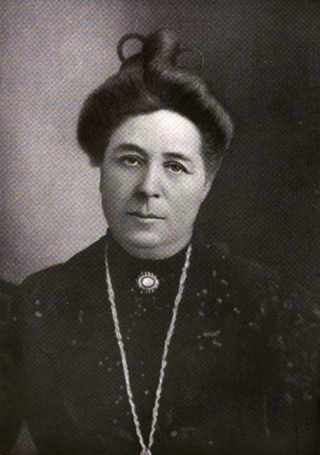
Lilah Denton Lindsey was a Native American philanthropist, civic leader, women's community organizer, temperance worker, and teacher. She was the first Muscogee woman to earn a college degree. She led numerous civic organizations and served as president of the Indian Territory Woman's Christian Temperance Union (WCTU).
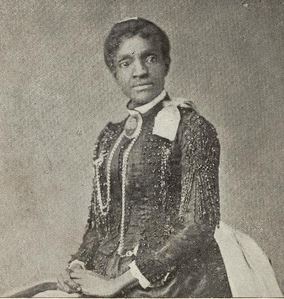
Nellie A. Ramsey Leslie was notable as a teacher, musician and composer, working in Louisiana and Mississippi, and then in Indian Territory and Corpus Christi, Texas, where she founded a musical conservatory for girls. Born into slavery in Virginia, after emancipation she gained schooling in Ohio and moved to Louisiana to teach for the Freedmen's Bureau. She attended the Normal School of Straight University and gained further training as a teacher. Teaching in Louisiana, Mississippi, Indian Territory, and Texas, Leslie educated freedmen and their children. She was widely known as a music educator and composer, as well as performer, although none of her works is known to be extant.
References
- ↑ "National Register Information System". National Register of Historic Places . National Park Service. July 9, 2010.
- 1 2 "Augusta Robertson Moore, A Sketch of Her Life and Times". Oklahoma Historical Society. Retrieved January 15, 2008.
- ↑ "Church's 1875 origin linked to missionary". Tulsa World. Retrieved January 15, 2008.
- 1 2 3 "Historic All-Black Towns in OK Tullahassee". Tulsa Library. Archived from the original on October 16, 2007. Retrieved January 15, 2008.
- 1 2 Steineker, R.F. (2016). "'Fully equal to that of any children': Experimental Creek Education in the Antebellum Era." History of Education 56, no. 2. 273-300. Academic Search Premier.
- ↑ "46th Annual Report of the Board of Foreign Missions of the Presbyterian Church of the U.S.A.". May 1883. Retrieved April 12, 2013. Available via Google Books.
- 1 2 Zellar, Gary. "Tullahassee Manual Labor School (1850-1924)," Retrieved May 12, 2012.
- ↑ O'Dell, Larry. "Tullahassee." Archived 2012-11-04 at the Wayback Machine Encyclopedia of Oklahoma History and Culture. Accessed July 8, 2012.]